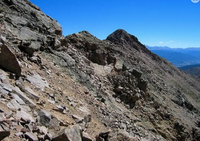Incident Report: Hiking – Keller Mountain - Sat, Aug 17, 2024 - Gore Range
Title: Hiking – Keller Mountain
Location: Keller Mountain, SE approach, Summit County
Activity Details:
Type: Hiking
Date: Aug 17, 2024
Category: Trip
Group: Gore Range
Mileage & Elevation Gain: 5.5 miles, 3,000’ gain
Participants: 4 members
Incident Information:
Category: Incident (physical)
Date & Time of Incident: Aug 17, 2024, 10:45 AM
Location: Off trail, rock terrain, during ascent
Injury Details:
Type: Laceration to chin and lip
Cause: Rock dislodged by another member, hitting injured party after she looked up when "rock" was yelled
Injury Treatment: Required stitches, no concussion
Contributing Factors:
Immediate Cause: Rock dislodged by a party member on steep grassy slope
Contributory Cause: Lack of helmet usage; no prior discussion about rock fall hazard
Analysis: The terrain did not initially seem risky for rock fall, but the slope steepness indicated potential danger. Leaders concluded that a discussion about rock fall and helmet use should have occurred earlier. Proper protocol when hearing "rock" includes not looking up and seeking immediate protection. The injury could have been mitigated with better preparation and safety reminders.
Comments (Graham Ottley - Education Director): This is a scenario that we are all familiar with as mountaineers. The hike begins without the risk of rockfall danger but the terrain gradually shifts and changes as we progress towards the summit. A few thoughts:
- As indicated in the analysis portion of the IR, the leader recognized the need to front-load that portion of their ascent with information about what to do BEFORE they entered the terrain.
- Mountain Project describes this ridge ascent as 3rd class which is below the level that requires the use of helmets but Trip Leaders can certainly make a more conservative decision and require them. We have all experienced a 3rd class route "feeling" like 4th class and we have all also gotten off route.
- Safe Ascent Strategies for Loose Scree or Talus
- Pause and Assess: When terrain changes or difficulty levels increase, take a moment to stop and evaluate. This creates an opportunity for open communication and allows you to gauge the comfort level of your participants.
- Evaluate the Route: Don’t assume the group must continue. Consider alternatives or whether this is a good turnaround point, based on your group's composition. Are participants trained and equipped to continue, or would it be safer to alter the plan?
- Travel Close Together: Instruct the group to ascend close together ("nose to butt") so that any dislodged rocks won’t build enough momentum to become hazardous.
- Use a Corral System: Establish a safe stopping area before and after tricky sections, away from the fall line. Ensure participants wait there while others traverse, minimizing the risk of rockfall injuries.
For more discussion read this excellent blog article from our friends at the Mountaineers: How To: Navigate Loose Rock
 Graham Ottley
Graham Ottley

Add a comment
Log in to add comments.